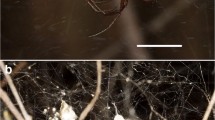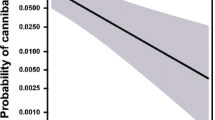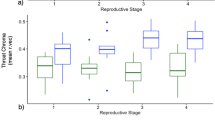Abstract
Conflict between the sexes over mating decision may result in antagonistic coevolution in structures that increase control over copulation. In Aquarius paludum both females and males have long abdominal spines. We tested the hypothesis that abdominal spines increase female ability to resist male mating attempts and reduce the costs of mating in A. paludum. We manipulated female spine length and observed female mating and egg-production rate in two different studies. We found that females with intact spines succeeded to reject male mating attempt more often than females with removed spines. Intact females also mated less often than females with removed or shortened spines. Male presence and mating rate increased female egg number. Our results thus support the hypothesis that abdominal spines help female to reject male mating attempts but contrary to predictions, we found that A. paludum females somehow benefit from multiple matings in spite of the sexual conflict.
Similar content being viewed by others
References
Andersen, N. M. (1982). The Semiaquatic Bugs (Hemiptera, Gerromorpha): Phylogeny, Adaptations, Biogeography and Classification. Entomonograph 3, Scandinavian Science Press, Klampenborg, Denmark.
Andersen, N. M. (1993). Classification, phylogeny, and zoogeography of the pond skater genus Gerris fabricius (Hemiptera, Gerridae). Can. J. Zool. 71: 2473–2508.
Andersen, N. M. (1997). A phylogenetic analysis of the evolution of sexual dimorphism and mating systems in water striders (Hemiptera: Gerridae). Biol. J. Linn. Soc. 61: 345–368.
Arnqvist, G. (1989a). Multiple mating in water strider: Mutual benefits or intersexual conflict? Anim. Behav. 38: 749–756.
Arnqvist, G. (1989b). Sexual selection in a water strider: The function, mechanism of selection and heritability of a male grasping apparatus. Oikos 56: 344–350.
Arnqvist, G. (1992). Pre-copulatory fighting in a water strider: Intersexual conflict or mate assessment? Anim. Behav. 43: 559–567.
Arnqvist, G. (1997). The evolution of water strider mating systems: Causes and consequences of sexual conflicts. In Choe, J. C., and Crespi, B. J. (eds.), The Evolution of Mating Systems in Insects and Arachnids, Cambridge, Cambridge University Press, pp. 146–163.
Arnqvist, G., and Nilsson, T. (2000). The evolution of polyandry: Multiple mating and female fitness in insects. Anim. Behav. 60: 145–164.
Arnqvist, G., and Rowe, L. (1995). Sexual conflict and arms races between the sexes: A morphological adaptation for control of mating in a female insect. Proc. R. Soc. Lond. Ser. B 261: 123–127.
Arnqvist, G., and Rowe, L. (2002). Correlated evolution of male and female morphologies in water striders. Evolution 56: 936–947.
Bateman, A. J. (1948). Intra-sexual selection in drosophila. Heredity 2: 349–368.
Chapman, T., Arnqvist, A., Bangham, J., and Rowe, L. (2003). Sexual conflict. TREE 18: 41–47
Chen, P. S. (1984). The functional morphology and biochemistry of insect male accessory glands and their secretions. Ann. Rev. Entom. 29: 233–255.
Daly, M. (1978). The cost of mating. Am. Nat. 112: 771–774.
Fairbairn, D. J. (1993). Cost of loading associated with mate-carrying in the water strider, Aquarius regimis. Behav. Ecol. 4: 224–231.
Gromko, M. H., Newport, M. E., and Kortier, M. G. (1984). Sperm dependence of female reproductive success in bushcrickets. Evolution 38: 1273–1282.
Hurst, G. D. D., Sharpe, R. G., Bloomfield, A. H., Walker, L. E., Majerus, T. M. O., Zacharov, I. A., and Maherus, M. E. N. (1995). Sexually transmitted disease in a promiscuous insect, Adalia bipunctata. Ecol. Ent. 20: 230–236.
Kaitala, A. (1987). Dynamic life-history strategy of the waterstrider Gerris thoracicus as an adaptation to food and habitat variation. Oikos 48: 125–131.
Opp, S. B., and Propoky, R. J. (1986). Variation in laboratory oviposition by Rhagoletis pomonella (Diptera: Tephitidae) in relation to mating status. Ann. Ent. Soc. Am. 79: 705–710.
Parker, G. A. (1979). Sexual selection and sexual conflict. In Blum, M. S., and Blum, N. A. (eds.), Sexual Selection and Reproductive Competition in Insects, Academic Press, New York, pp. 123–166.
Rowe, L. (1992). Convenience polyandry in a water strider: Foraging conflicts and female control of copulation frequency and guarding duration. Anim. Behav. 44: 189–202.
Rowe, L., and Arnqvist, G. (2002). Sexually antagonistic coevolution in a mating system: Combining experimental and comparative approaches to address evolutionary processes. Evolution 56: 754–767.
Rowe, L., Arnqvist, G., Sih, A., and Krupa, J. J. (1994). Sexual conflict and the evolutionary ecology of mating patterns: Water striders as a model system. TREE 8: 289–293.
Tabachnick, B. G., and Fidell, L. S. (1996). Using Multivariate Statistics, Addison-Wesley, Boston.
Trivers, R. L. (1972). Parental investment and sexual selection. In Campbell, B. (ed.), Sexual Selection and the Descent of Man, Aldine, Chicago, pp. 1871–1971.
Watson, P. J., Arnqvist, G., and Stallmann, R. R. (1998). Sexual conflict and the energetic costs of mating and mate choice in water striders. Am. Nat. 151: 46–58.
Wing, S. R. (1988). Cost of mating for female insects: Risk of predation in Photinus collustrans (Coleoptera, Lamyridae). Am. Nat. 131: 139–142.
Wolfner, M. F. (1997). Tokens of love: Functions and regulation of Drosophila male accessory glands products. Insect Biochem. Mol. Biol. 27: 179–192.
Author information
Authors and Affiliations
Corresponding author
Rights and permissions
About this article
Cite this article
Ronkainen, K., Kaitala, A. & Huttunen, R. The Effect of Abdominal Spines on Female Mating Frequency and Fecundity in a Water Strider. J Insect Behav 18, 619–631 (2005). https://doi.org/10.1007/s10905-005-7015-6
Revised:
Accepted:
Issue Date:
DOI: https://doi.org/10.1007/s10905-005-7015-6




